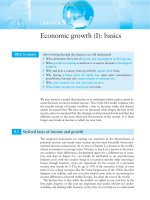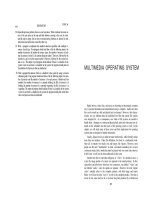Ebook Evidence-based critical care (3rd edition): Part 1
Bạn đang xem bản rút gọn của tài liệu. Xem và tải ngay bản đầy đủ của tài liệu tại đây (3.73 MB, 351 trang )
Paul Ellis Marik
Evidence-Based
Critical Care
Third Edition
123
Evidence-Based Critical Care
Paul Ellis Marik
Evidence-Based Critical Care
Third Edition
Paul Ellis Marik
Division of Pulmonary and Critical Care Medicine
Eastern Virginia Medical School
Norfolk, VA, USA
ISBN 978-3-319-11019-6
ISBN 978-3-319-11020-2 (eBook)
DOI 10.1007/978-3-319-11020-2
Springer Cham Heidelberg New York Dordrecht London
Library of Congress Control Number: 2014956872
© Springer International Publishing Switzerland 2015
This work is subject to copyright. All rights are reserved by the Publisher, whether the whole or part of
the material is concerned, specifically the rights of translation, reprinting, reuse of illustrations, recitation,
broadcasting, reproduction on microfilms or in any other physical way, and transmission or information
storage and retrieval, electronic adaptation, computer software, or by similar or dissimilar methodology
now known or hereafter developed. Exempted from this legal reservation are brief excerpts in connection
with reviews or scholarly analysis or material supplied specifically for the purpose of being entered and
executed on a computer system, for exclusive use by the purchaser of the work. Duplication of this
publication or parts thereof is permitted only under the provisions of the Copyright Law of the Publisher’s
location, in its current version, and permission for use must always be obtained from Springer.
Permissions for use may be obtained through RightsLink at the Copyright Clearance Center. Violations
are liable to prosecution under the respective Copyright Law.
The use of general descriptive names, registered names, trademarks, service marks, etc. in this publication
does not imply, even in the absence of a specific statement, that such names are exempt from the relevant
protective laws and regulations and therefore free for general use.
While the advice and information in this book are believed to be true and accurate at the date of
publication, neither the authors nor the editors nor the publisher can accept any legal responsibility for
any errors or omissions that may be made. The publisher makes no warranty, express or implied, with
respect to the material contained herein.
Printed on acid-free paper
Springer is part of Springer Science+Business Media (www.springer.com)
Learning without thinking is useless. Thinking without learning is dangerous.
—Confucius, Chinese Philosopher (551–479 BC)
To cure sometimes, to relieve often, to comfort always.
—Hippocrates, Greek Physician, Father of Western Medicine (460–370 BC)
This book is dedicated to the memory
of my father, Colin Sigmund Marik,
a man of great intellect and wit.
Preface to Third Edition
After completing the Second Edition of The Handbook of Evidence Based Critical
Care in 2009, I swore that I would rather stick needles in both my eyes than author
another updated version of the book. But here we are in 2015 with the Third Edition
of Evidence-Based Critical Care (no longer a handbook). So what made me change
my mind? Most importantly, you, my dedicated readers, have implored me to update
the book; I was told, “Medicine as we know it would be incomplete without an
updated version.” Your enthusiastic and positive feedback was the driving factors
which led me to consider writing this revision. In addition, in the last 5 years we
have witnessed a remarkable refinement in the management strategies of critically
ill patients best characterized as “Less is More” (see Chap. 2). At the same time we
have realized that while many of our patients survive their ICU stay, many have
significant residual functional and cognitive disabilities. These changes in our
approach and understanding of critical illness have necessitated the updated Third
Edition of Evidence-Based Critical Care.
However, the basic guiding principles of Critical Care Medicine have not
changed; compassionate, dedicated and thoughtful clinicians, who evaluate the
functioning of the “whole” patient, ponder their disease processes and pathophysiology and provide the highest level of Evidence-Based interventions with the goal
of restoring the patient to a quality of life which he/she values.
Due to the vast number of therapeutic interventions that ICU physicians make
daily, the topics are presented as narrative summaries of the best available evidence
rather than as systematic reviews of each and every intervention. In keeping with the
goal of providing an evidence-based approach to critical care, references are
provided to support the evidence presented. In writing this book my goal has been
to take issues that appear complex and make them as simple as possible.
ix
x
Preface to Third Edition
It appears to me that those who really don’t have a good understanding of the
complexities of physiology, pathophysiology and patient care make things so complicated that they themselves don’t understand what they are trying to convey. This
concept is exemplified by the following quotes:
Make everything as simple as possible, but not simpler
If you can’t explain it simply, you don’t understand it well enough
Albert Einstein, Theoretical Physicist, 1879–1955
Evidence-Based Critical Care is not a reference text but presents a practical
evidence-based approach to the management of critically ill ICU patients. The
focus of this book is on issues that pertain specifically to the ICU. As such, the
reader is referred to standard medical and surgical texts as well as online resources
for more complete information on the wide spectrum of conditions and diseases
from which ICU patients may suffer. While all attempts have been made to be
current, due to the exponential growth of medical knowledge some of the information presented may already be outdated when this book comes to print. The reader
should therefore keep up-to-date with the current medical literature.
The guidelines presented in the book are not meant to replace clinical judgment,
but rather to provide a framework for patient management. Individual clinical situations can be highly complex and the judgment and wisdom of an experienced and
knowledgeable intensivist with all available information about a specific patient is
essential for optimal clinical management.
Norfolk, VA, USA
Paul Ellis Marik
Acknowledgements
This book recognizes my mentors and students who have taught me everything
I know and inspired me to learn even more.
xi
A Note to the Reader
The author and publisher have made every attempt to check information and
dosages for accuracy. Because information and the science of pharmacology is
continually advancing, our knowledge base continues to expand. Therefore, we
recommend that the reader check all information and all product information for
changes, especially changes in dosages or administration before administering any
medication.
xiii
Contents
Part I
General ICU Topics
1
Evidence Based Critical Care ................................................................
References .................................................................................................
3
6
2
“Less Is More”: The New Paradigm in Critical Care .........................
References .................................................................................................
7
8
3
“Classic” Papers ......................................................................................
13
4
Critical Care Medicine 101 ....................................................................
Factors to Consider When a Patient is Admitted to the ICU.....................
Initial “Generic” Treatment Orders ...........................................................
Reference ..................................................................................................
19
20
20
21
5
House Officers Guidelines 1: Housekeeping .........................................
Admission History and Physical Examination .........................................
Daily Examination ....................................................................................
General ..................................................................................................
Vital Signs (24 h Min and Max and Current) .......................................
Additional Observations .......................................................................
The Ventilator ........................................................................................
Heart......................................................................................................
Chest .....................................................................................................
Abdomen ...............................................................................................
CNS .......................................................................................................
Importance of the Daily Neurological Examination .............................
Laboratory Tests ........................................................................................
Imaging .....................................................................................................
Presenting on Daily Rounds......................................................................
New Admissions ...................................................................................
23
23
24
24
24
24
25
25
25
25
26
26
26
27
27
27
xv
xvi
Contents
Follow Up Patients ................................................................................
Clinical Pearls ...........................................................................................
References .................................................................................................
28
28
28
6
House Officers Guidelines 2: Procedures .............................................
Murphy’s Laws of Procedures ..................................................................
Central Venous Access ..............................................................................
Subclavian Vein Catheterization ...........................................................
Internal Jugular Vein Catheterization ....................................................
Femoral Vein Catheterization................................................................
Complications of Central Venous Access .............................................
Arterial Catheters ......................................................................................
Naso/Oro Gastric Tubes ............................................................................
Feeding Tubes ...........................................................................................
Thoracentesis and Paracentesis .................................................................
Clinical Pearls .......................................................................................
References .................................................................................................
29
29
30
31
32
33
34
34
35
36
36
37
37
7
Admission-Discharge Criteria ...............................................................
ICU Admission Criteria ............................................................................
Prioritization of Potential ICU Admissions ..............................................
Priority 1 ...............................................................................................
Priority 2 ...............................................................................................
Priority 3 ...............................................................................................
Priority 4 ...............................................................................................
Transfer from Another Hospital: Variable Priority ...............................
Disease Specific Indications for ICU Admission ......................................
Cardiovascular System ..........................................................................
Pulmonary System ................................................................................
Neurological Disorders .........................................................................
Drug Ingestion and Drug Overdose ......................................................
Gastrointestinal Disorders.....................................................................
Endocrine ..............................................................................................
Renal Disorders.....................................................................................
Postoperative Care ................................................................................
Miscellaneous .......................................................................................
Physiologic Indication for ICU Admission ...............................................
Discharge Criteria .....................................................................................
Reference ..................................................................................................
39
39
40
40
40
40
41
41
41
41
42
42
42
43
43
43
44
44
44
44
45
8
Chronic Critical Illness and the Long Term Sequela
of Critical Care ........................................................................................
Neuromuscular Abnormalities ..................................................................
Critical Illness Polyneuropathy .............................................................
Critical Illness Myopathy (See also Chap. 32 on Nutrition) .................
Brain Dysfunction .................................................................................
“Prevention” of CCI ..................................................................................
47
49
49
49
51
51
Contents
9
10
xvii
Management of CCI..................................................................................
Testing ...................................................................................................
General Management ............................................................................
Stress Hyperglycemia ...........................................................................
Metabolic Bone Disease .......................................................................
Anabolic Steroids ..................................................................................
Exercise Program ..................................................................................
References .................................................................................................
52
52
53
53
53
54
54
54
Fluid Responsiveness and Fluid Resuscitation .....................................
Echocardiographic Assessment of Fluid Responsiveness .........................
Static Echocardiographic Parameters....................................................
Dynamic Echocardiographic Parameters ..............................................
Passive Leg Raising (PLR) .......................................................................
The Fluid Challenge..................................................................................
Fluid Boluses in Volume Responsive Patients ..........................................
What Type of Fluid? .................................................................................
Lactated Ringer’s (Hartmann’s Solution) vs. 0.9 % NaCl
(Ab-Normal Saline) ..............................................................................
Complications Associated with 0.9 % NaCl vs. Lactate
Ringers Solution........................................................................................
Renal Failure .........................................................................................
Hyperchloremic Metabolic Acidosis and DEATH ................................
Lactate Generates HCO3− .......................................................................
Ringer’s Lactate and Kidney Disease ...................................................
Ringers Lactate and Liver Disease........................................................
Coagulopathy ........................................................................................
Lactate as a Metabolic Fuel ..................................................................
Albumin ....................................................................................................
Hetastarches (HES) ...................................................................................
So, Which Fluid?.......................................................................................
Resuscitation in Specific Disease States ...................................................
Hemorrhage...........................................................................................
Traumatic Brain Injury..........................................................................
Dehydration...........................................................................................
Sepsis (and SIRS) .................................................................................
Burns .....................................................................................................
Management of Oliguria ...........................................................................
Management of Volume Overload/Acute Pulmonary Edema ...............
References .................................................................................................
57
66
66
66
67
69
71
72
Assessment of Cardiac Function and Cardiac Output ........................
Echocardiographic Assessment of Cardiac Function ................................
Methods of Measuring Cardiac Output.....................................................
Pulmonary Artery Catheter ...................................................................
Transpulmonary Thermodilution ..........................................................
89
89
90
90
91
72
73
73
73
73
74
75
75
75
76
77
78
78
78
79
79
80
80
80
81
81
xviii
Contents
Pulse Contour Analysis .........................................................................
Esophageal Doppler ..............................................................................
USCOM ................................................................................................
Bioreactance ..........................................................................................
Utility of Cardiac Output monitoring .......................................................
Determining Fluid and Inotrope Responsiveness .................................
Driving up CI to Supranormal Values ...................................................
References .................................................................................................
92
93
93
94
94
94
94
95
11
Peri-operative Fluid Optimization ........................................................ 99
References ................................................................................................. 104
12
Sepsis ........................................................................................................
Bacteriology and Sites of Infection...........................................................
Pathophysiology of Sepsis ........................................................................
Septic “Cardiomyopathy” .....................................................................
Complications Associated with Sepsis..................................................
Clinical Features and Diagnosis of Sepsis ................................................
Organ Dysfunction in Severe Sepsis/Septic Shock ...............................
Management of Sepsis ..............................................................................
Antibiotic Therapy ................................................................................
Fluid Therapy (See also Chap. 9)..........................................................
Vasopressors and Inotropic Agents .......................................................
B-Blockers and Phenylephrine in Septic Shock ...................................
Resuscitation End-Points ......................................................................
The Dangers of a HIGH CVP ...............................................................
Does Tissue Hypoxia and Mitochondrial Dysfunction
Exist in Sepsis? .....................................................................................
Case Example............................................................................................
References .................................................................................................
13 The Stress Response, Stress Hyperglycemia
and Stress Hyperlactemia..........................................................................
The Stress Response .................................................................................
Cardiovascular Effects of the Stress Response .....................................
Immune Effects of the Stress Response ................................................
Metabolic Effects of the Stress Response .............................................
Stress Hyperglycemia ...............................................................................
Treatment of “Stress Hyperglycemia” ..................................................
So What to Do! .....................................................................................
How to Achieve These Goals? ..............................................................
Glucose Control and Steroids ...............................................................
Stress Hyperlactemia ................................................................................
Lactate Metabolism...............................................................................
Lactate as a Marker of Illness Severity .................................................
Lactate as a Marker of Metabolic Stress ...............................................
107
108
109
109
111
112
112
115
118
119
124
128
129
130
133
136
137
149
149
152
152
153
153
155
157
157
158
158
159
160
161
Contents
Lactate as a Metabolic Fuel ..................................................................
Heart Metabolism and Lactate ..............................................................
Brain Metabolism and Lactate ..............................................................
References .................................................................................................
14
15
Understanding the Vital Signs: BP, HR, RR, TEMP,
SaO2 … and SV .......................................................................................
Blood Pressure ..........................................................................................
The Brain-Heart Distance and the Giraffe Theory of Blood Pressure
Determination in Humans .....................................................................
What’s a Normal Blood Pressure? ........................................................
BP Thresholds for the Intensivist/Anesthesiologist ..............................
Non-Invasive Blood Pressure (NIBP) vs Arterial Line Blood Pressure
(IAP) and Systolic Blood Pressure (SBP) vs Mean Arterial
Pressure (MAP).....................................................................................
Central vs Peripheral Blood Pressure Measurement .............................
Blood Pressure Autoregulation .............................................................
MAP, Organ Failure and Death .............................................................
Circulatory Shock .....................................................................................
Pulse Rate..................................................................................................
Respiratory Rate (& Pattern) ....................................................................
Temperature ..............................................................................................
Pulse Oximetry..........................................................................................
Too Much Oxygen Kills............................................................................
Analysis of the Oximetric Waveform....................................................
Stroke Volume: The 6th Vital Sign ............................................................
Putting the Vital Signs Together................................................................
Early Warning Scoring Systems and Rapid Response Teams...............
References .................................................................................................
Management of Pain, Agitation and Delirium .....................................
Assessing the Level of Pain and Sedation.................................................
The Ramsey Sedation Scale ..................................................................
The Richmond Agitation-Sedation Scale (RASS) ................................
Sedation Vacations ....................................................................................
Non-pharmacologic Interventions.............................................................
Delirium ....................................................................................................
Sedative and Analgesics Agents ................................................................
Lorazepam.............................................................................................
Midazolam ............................................................................................
Propofol.................................................................................................
Dexmedetomidine .................................................................................
Haloperidol ...........................................................................................
Fentanyl.................................................................................................
Morphine ...............................................................................................
Meperidine ............................................................................................
xix
162
163
163
164
169
169
170
171
172
172
173
174
175
176
177
178
179
179
184
188
189
190
191
192
197
200
201
201
202
202
202
205
205
206
206
207
208
208
208
208
xx
Contents
Neuromuscular Blockade .......................................................................... 209
Neuromuscular Blocking Agents .......................................................... 209
References ................................................................................................. 210
16
Hospital Acquired Infections and Their Prevention ............................
Colonization with Multidrug Resistant Organisms...................................
Handwashing and Infection Control Measures .........................................
Handwashing.........................................................................................
Chlorhexidine Bathing ..........................................................................
Gloves and Gowns and Healthcare Provider Apparel ...........................
Universal Screening for MDR’s and “Protective Isolation” .................
Oropharyngeal and Gastrointestinal Decolonization ............................
Private Rooms and Environmental Control ..........................................
Central Line Associated Blood Stream Infection......................................
Management of CLABSI’s ...................................................................
Antibiotics Lock Therapy .....................................................................
Prevention of CLABSI ..........................................................................
Catheter Associated Urinary Tract Infection.............................................
Ventilator Associated Pneumonia .............................................................
Pathogenesis of VAP .............................................................................
Diagnosis of VAP ..................................................................................
Treatment ..............................................................................................
General Concepts for the Antimicrobial Treatment of VAP .................
Empiric Antibiotic Choices ...................................................................
“Specific” Interventions for Prevention of VAP....................................
Clostridium difficile Infection ...............................................................
Laboratory Diagnosis ............................................................................
Sigmoidoscopy ......................................................................................
Treatment ..............................................................................................
Fidaxomicin ..........................................................................................
Adjunctive Treatment Options ..............................................................
Probiotics ..............................................................................................
Surgical Intervention .............................................................................
Nosocomial Rhinosinusitus ......................................................................
References .................................................................................................
Part II
17
213
215
216
216
216
217
217
218
219
220
224
225
225
227
229
230
232
234
234
235
235
239
241
242
243
244
244
245
245
246
248
Pulmonary
The Bacterial Pneumonias: A New Treatment Paradigm ...................
Unified Treatment Algorithm ....................................................................
No Risk Factors for a CAP-DRP ..........................................................
Risk Factors for CAP-DRPs .................................................................
Influenza (Co-Existent or Influenza Pneumonia) ..................................
Diagnostic Testing of Hospitalized Patients with Pneumonia ..............
Non-Infectious Diseases Masquerading as Pneumonia ........................
Special Considerations ..............................................................................
Severe CAP with no MDR Risk Factors ...............................................
261
263
263
264
264
265
265
266
266
Contents
xxi
Community-Acquired MRSA Pneumonia (CA-MRSA) ......................
Aspiration Pneumonia...........................................................................
Nursing Home-Acquired Pneumonia ....................................................
Persistent Temperature/Failure to Respond to Rx.................................
Unusual Pathogens ................................................................................
Complicated Pleural Effusion/Empyema ..............................................
References .................................................................................................
266
267
269
269
270
271
271
18
Fever .........................................................................................................
Common Misconception and Fables .........................................................
Pathogenesis of Fever ...............................................................................
Treatment of Fever ................................................................................
Causes of Fever in the ICU .......................................................................
Infectious Causes of Fever in the ICU ..................................................
Non-Infections Causes of Fever in the ICU ..........................................
Non-Infectious Causes of Fever ............................................................
An Approach to the Febrile ICU Patient ...................................................
Clinical Pearls ...........................................................................................
References .................................................................................................
275
275
276
276
278
279
279
279
286
288
288
19
Mechanical Ventilation 101 ....................................................................
Alveolar Overdistension Damages Normal Lungs ...................................
Ventilator Variables and Modes of Ventilation ..........................................
Ventilator Variables (See Table 19.1) ....................................................
Common Modes of Mechanical Ventilation .............................................
Positive End-Expiratory Pressure (PEEP) ............................................
Auto-PEEP ................................................................................................
Monitoring Patients Undergoing Mechanical Ventilation.....................
Sudden Increase in Airway Pressure and/or Fall
in Arterial Saturation .............................................................................
When to Perform a Tracheostomy ............................................................
Timing of Tracheostomy in the Critically Ill ........................................
References .................................................................................................
291
293
293
297
299
303
305
306
Non-invasive Ventilation .........................................................................
Set Up........................................................................................................
Initial Settings ...........................................................................................
Indications of NIV ....................................................................................
COPD Exacerbations ............................................................................
Acute Cardiogenic Pulmonary Edema ..................................................
Facilitating Extubation in COPD Patients ............................................
Immunocompromised Patients..............................................................
Post-operative Patients ..........................................................................
When to Use NIV......................................................................................
Hypercapnic Respiratory Failure ..........................................................
Hypoxemic Respiratory Failure ............................................................
311
312
312
313
313
313
313
314
314
315
315
315
20
307
307
308
308
xxii
Contents
Contraindications to NIPPV ................................................................. 315
Success and Failure Criteria for NIPPV ............................................... 316
References ................................................................................................. 316
21
Liberation (Weaning from Mechanical Ventilation) ............................
General Concepts ......................................................................................
Effect of Liberation on Oxygen Consumption and Cardiac Function ..
Fluid Overload and Liberation Failure..................................................
Vasopressors and Inotropic Agents and Weaning .................................
Mechanical Ventilation Liberation Process ..............................................
“Readiness” Testing ..............................................................................
Spontaneous Breathing Trials ...............................................................
Causes of Liberation Failure .................................................................
Early Extubation Followed by NIV in COPD ......................................
NIV for Persistent Liberation Failure ...................................................
Extubation Failure .................................................................................
Patients at High Risk of Extubation Failure..........................................
The Cuff Leak Test....................................................................................
Corticosteroids for the Prevention of Post-extubation Stridor ..............
References .................................................................................................
319
319
320
320
321
322
322
323
324
324
324
325
325
326
326
326
22
Arterial Blood Gas Analysis...................................................................
Indications for ABG Sampling..................................................................
ABG Sampling ..........................................................................................
ABG Analysis ...........................................................................................
Alveolar Ventilation ..............................................................................
Oxygenation ..........................................................................................
Acid-Base Balance ................................................................................
A Step Wise Approach to Acid-Base Disorders ........................................
Common Acid Base Disturbances in the ICU...........................................
Metabolic Acidosis................................................................................
Metabolic Alkalosis ..............................................................................
Venous Blood Gas Analysis (VBGs) ........................................................
Mixed Venous/Central Venous Oxygen Saturation ...................................
References .................................................................................................
329
329
330
331
332
332
334
335
338
338
341
342
343
344
23
ARDS........................................................................................................
Definition, Causes and Assessment of Severity ........................................
Definition of ALI According the American European Consensus ........
Acute Lung Injury (ALI) ......................................................................
Acute Respiratory Distress Syndrome (ARDS) ....................................
Pathophysiological Definition of ARDS ...............................................
Causes of ALI .......................................................................................
Management of the Acute Phase of ARDS ...............................................
Ventilatory Strategy ..............................................................................
Pressure Controlled Ventilation.............................................................
349
349
349
349
350
350
351
351
352
355
Contents
xxiii
Airway Pressure Release Ventilation ....................................................
Permissive Hypercapnia ........................................................................
Best PEEP .............................................................................................
Recruitment Maneuvers ........................................................................
Non-Ventilatory Adjuncts to Gas Exchange .............................................
Prone Positioning ..................................................................................
Neuromuscular Blocking Agents ..........................................................
ECMO .......................................................................................................
Corticosteroids ......................................................................................
Inhaled Nitric Oxide .............................................................................
Nebulized Prostacyclin .........................................................................
β2-Adrenergic Receptor Agonists ..........................................................
Surfactant ..............................................................................................
Omega-3 Enteral Nutrition....................................................................
“Our” Approach to Refractory Hypoxemia ..............................................
References .................................................................................................
357
359
359
361
361
361
362
362
363
365
365
365
365
366
366
367
24
COPD Exacerbation ...............................................................................
Common Precipitating Events ..................................................................
Indications for Hospitalization..................................................................
Indications for ICU Admission .................................................................
Treatment ..................................................................................................
Indications for NPPV ................................................................................
Indications for Endotracheal Intubation....................................................
Mechanical Ventilation in COPD ..............................................................
Suggested Initial Settings..........................................................................
References .................................................................................................
373
374
375
375
375
377
377
377
378
378
25
Acute Severe Asthma ..............................................................................
Indications for Admission to the ICU .......................................................
Initial Treatment ........................................................................................
Other Therapeutic Options ....................................................................
Complications of Acute Asthma ...............................................................
Noninvasive Positive-Pressure Ventilation in Status Asthmaticus ............
Indications for Intubation..........................................................................
Sedation Post-intubation ...........................................................................
Mechanical Ventilation..............................................................................
Initial Ventilator Settings...........................................................................
References .................................................................................................
381
382
382
383
384
384
385
386
386
387
388
26
Pleural Effusions and Atelectasis ..........................................................
Pleural Effusions .......................................................................................
Pathophysiology ....................................................................................
Drainage of Pleural Effusion.................................................................
Hepatic Hydrothorax .................................................................................
391
391
391
392
393
xxiv
27
Contents
Alelectasis .................................................................................................
Respiratory Therapy ..............................................................................
Mucolytics.............................................................................................
Bronchoscopy .......................................................................................
Bilevel/APRV ........................................................................................
References .................................................................................................
393
394
394
395
395
396
Venous Thromboembolic Disease: DVT and PE ..................................
Pregnancy, Venous Thromboembolism and Thrombophilias....................
Site of Venous Thrombosis .......................................................................
The Veins of the Lower Limb ...............................................................
Suggested DVT Prophylaxis Protocols .....................................................
Diagnosis of DVT .....................................................................................
Distal Lower Extremity DVT....................................................................
Upper Extremity DVT ..............................................................................
Superficial Phlebitis ..............................................................................
Pulmonary Embolism................................................................................
Diagnosis of Pulmonary Embolism ......................................................
Treatment of Thromboembolic Disease ................................................
Thrombolytic Therapy ..........................................................................
Catheter Directed Clot Fragmentation and Aspiration..........................
Inhaled Nitric Oxide .............................................................................
Vena Caval Interruption ........................................................................
“Absolute Contraindications” for Anticoagulation with Heparin .........
References .................................................................................................
399
399
400
401
405
405
406
406
407
408
408
411
413
418
418
419
419
419
Part III
28
Cardiac
Hypertensive Crises ................................................................................
Definitions .................................................................................................
Pathophysiology ........................................................................................
Clinical Presentation .................................................................................
Initial Evaluation ...................................................................................
Initial Management of Blood Pressure .....................................................
Resident (or Hospitalist) Called to the Floor for High
Blood Pressure: What to Do? ................................................................
Drugs to AVOID ....................................................................................
Recommended Antihypertensive Agents ..............................................
Acute Postoperative Hypertension ........................................................
Pre-operative Hypertension...................................................................
Posterior Reversible Encephalopathy Syndrome (PRES) .........................
Pregnancy-Induced PRES .....................................................................
Drugs Associated with PRES ................................................................
References .................................................................................................
429
429
430
431
432
433
434
436
437
439
440
441
441
442
442









